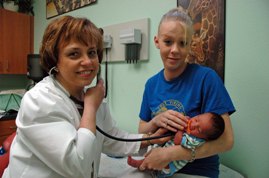Recovery Act (ARRA): Community Health Centers
The American Recovery and Reinvestment Act provides $2 billion to be invested in Community Health Centers, an unprecedented opportunity to serve more patients, stimulate new jobs, and meet the significant increase in demand for primary health care services among the Nation's uninsured and underserved populations. Over the next two years Recovery Act (ARRA) funding will be invested in Community Health Centers to support critically needed health care services, renovations and repairs and investments in health information technology.  - Increased Demand for Community Health Center Services (IDS). On March 27, HHS released $338 million in Recovery Act grants to expand services offered by Community Health Centers and enable them to serve more patients, as more Americans join the ranks of the uninsured.
- New Access Points. On March 2, President Barack Obama announced the release of $155 million in Recovery Act grants to support 126 Community Health Centers across the country. These New Access Point grants alone will help provide health services to 750,000 Americans and create 5,500 jobs.
Key Facts about Community Health CentersOne of every 19 people living in the U.S. now relies on a HRSA-funded clinic for primary care. - Nearly 1,100 health center grant recipients operate more than 7,000 community-based clinics in every state and territory, giving geographically isolated or economically distressed people access to preventive and primary health care.
- HRSA-supported health centers treated more than 16 million people in 2008.
- Nearly forty percent of patients treated have no health insurance and one-third are children
Community Health Centers: Engines of Economic GrowthCommunity Health Centers are a key source of local employment and economic growth in many underserved and low-income communities. - Community Health Centers support over 105,000 jobs, including physicians, nurses, dentists, and other health professionals; leveraging over $9 billion in needed health services.
- According to a recent study, Community Health Centers:
- Injected $7.3 billion of operating expenditures directly into their local economies;
- Produced additional indirect economic activity of $5.3 billion; and
- Created an estimated additional 53,000 jobs for the community.
Increasing Access and Expanding Available Services For more than four decades, the U.S. Department of Health and Human Services’ Health Resources and Services Administration (HRSA) has provided grant support for Health Centers that provide high-quality preventive and primary health care to medically underserved residents in cities and isolated rural areas. Today, Community Health Centers provide more comprehensive services than ever before. Services include pharmacy, mental health, substance abuse and oral health treatment, as well as supportive services that promote access to health care and ensure patient well-being. - In 2007, almost 2.8 million patients received dental services.
- More than 470,000 patients came to health centers for mental health care.
- Additionally, 92,000 patients made 916,000 visits to health centers for substance abuse treatment.
|









